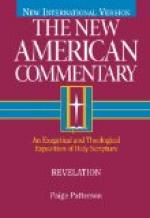Once more there is a steady process of deterioration in the four kingdoms. Gold is followed by silver, and that by brass, and that by the strange combination of iron and clay. This may simply refer to the diminution of worldly glory, but it may also mean deterioration, morally and otherwise. Is it not the teaching of Scripture that, unless God interpose, society will steadily slide downwards? And has not the fact been so, wherever the brake and lever of revelation have not arrested the decline and effected elevation? We are told nowadays of evolution, as if the progress of humanity were upwards; but if you withdraw the influence of supernatural revelation, the evidence of power in manhood to work itself clear of limitations and lower forms is very ambiguous at the best—in reference to morals, at all events. Evil is capable of development, as well as good; and perhaps Nebuchadnezzar’s colossus is a truer representation of the course of humanity than the dreams of modern thinkers who see manhood becoming steadily better by its own effort, and think that the clay and iron have inherent power to pass into fine gold.
The question of the identification of these successive monarchies does not fall to be discussed here. But I may observe that the definite statement of verse 44 (’in the days of these kings’) seems to date the rise of the everlasting kingdom of God in the period of the last of the four, and therefore that the old interpretation of the fourth kingdom as the Roman seems the most natural. The force of that remark may, no doubt, be weakened by the consideration that the Old Testament prophets’ perspective of the future brought the coming of Messiah into immediate juxtaposition with the limits of their own vision; but still it has force.
The allocation of each part of the symbol is of less importance for us than the lessons to be drawn from it as a whole. But the singular amalgam of iron and clay in the fourth kingdom is worth notice. No sculptor or metallurgist could make a strong unity out of such materials, of which the combination could only be apparent and superficial. The fact to which it points is the artificial unity into which the great conquering empires of old crushed their unfortunate subject peoples, who were hammered, not fused, together. ’They shall mingle themselves with the seed of men’ (ver. 43), may either refer to the attempts to bring about unity by marriages among different races, or to other vain efforts to the same end. To obliterate nationalities has always been the conquering despot’s effort, from Nebuchadnezzar to the Czar of Russia, and it always fails. This is the weakness of these huge empires of antiquity, which have no internal cohesion, and tumble to pieces as soon as some external bond is loosened. There is only one kingdom which has no disintegrating forces lodged in it, because it unites men individually to its king, and so binds them to one another; and that is the kingdom which Nebuchadnezzar saw in its destructive aspect.




